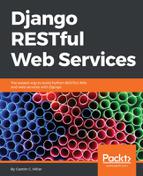In this chapter, we will start our journey towards creating RESTful Web Services with Python and its most popular web framework: Django. Python is one of the most popular and versatile programming languages. There are thousands of Python packages, which allow you to extend Python capabilities to any kind of domain you can imagine. You can work with Django and packages to easily build simple and complex RESTful Web Services with Python that can run on your favorite platform.
We will leverage your existing knowledge of Python and all of its packages to code the different pieces of your RESTful Web Services and their ecosystem. We will use object-oriented features to create code that is easier to maintain, understand, and reuse. We don't need to learn another programming language, we can use the one we already know and love: Python.
In this chapter, we will install and configure the environments and the required software and tools to create RESTful Web Services with Django and Django REST framework. We will learn the necessary steps in Linux, macOS, and Windows. We will gain an understanding of the following:
- Creating a virtual environment with Python 3.x and PEP 405
- Understanding the directory structure for a virtual environment
- Activating the virtual environment
- Deactivating the virtual environment
- Installing Django and Django REST framework in an isolated environment
- Creating an app with Django
- Understanding Django folders, files, and configurations
- Installing Curl
- Installing HTTPie
- Installing the Postman REST client
- Installing Stoplight
- Installing iCurlHTTP
